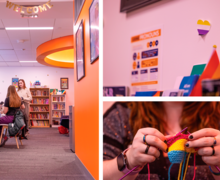Plans for sidewalks at SU heat up
This winter some areas of Syracuse University will have a new tool to combat the average 115.6 inches of snow: heated sidewalks around select campus buildings.
The system will be located beneath the sidewalks between Archbold Gymnasium and the Physics Building, said Eric Beattie, director of the Office of Campus Planning, Design and Construction, in an email. The project is part of maintenance work that started during the summer, which dealt with the installation of new sidewalks and pavement as well as landscaping and handicap accessible entrances, he said.
‘This means less salt will be tracked into the buildings, which reduces wear and tear on the floors and rusting of the metal door frames and stairs,’ he said.
The project, suggested by the Physical Plant ground crew, was proposed because the university recognized the area between the two buildings contained little room to pile snow, he said.
The snow melt system will reduce or completely eliminate the need for the area to be salted, or the use of heavy machinery to clear the snow, Beattie said. This not only reduces costs associated with physically clearing the snow, but also on maintenance to the surrounding buildings.
This is not the only place on campus with a similar snow melt system. An area near the Recreation Services facility at Archbold Gymnasium, installed a few years ago, has yielded similar results, he said.
The melt system on the ramp of Shaw Hall, which recently received new plastic tubing, is another successful example, said Rex Giardine, assistant director for capital projects.
‘The original system has been working for well over a decade,’ he said in an email.
The technology works by using the condensate water that is left over from the steam used to heat Archbold already, Beattie said. But because of the size of the system, it will require a small amount of additional energy, adding to the carbon footprint of the university, he said.
This type of system is already employed at Williams College and at Colgate University, Beattie said.
An analysis will be conducted comparing the start-up cost of the system to that of manual snow removal and the extended life of the surrounding facilities at a later date, Beattie said.
The project is expected to be operational in mid-December, Giardine said. The heat exchanger and piping are being installed in the basement of Archbold, he said. The contract for the construction was awarded to Viking Mechanical.
Olivia Nicotra, a sophomore chemical engineering major, was indifferent to the installation of this technology.
‘I’m not against it if it makes things safer,’ she said. ‘I’ve never had any problems getting into the (Physics) building.’
But Claire Rupert, a sophomore international relations major, said she feels the project will alleviate problems she has experienced navigating through that area in the past.
‘I think it’s a good idea,’ she said. ‘I remember last year coming back from the Dome that there was a lot of ice, and I was afraid that I was going to fall.’
Ryan Reed, a junior paper engineering major at the State University of New York College of Environmental Science and Forestry, is more concerned about how the system works — specifically, any environmental effects it may have — rather than the prospect of easier building accessibility in the winter.
Said Reed: ‘I think they do a pretty good job removing snow, so I don’t think it’s necessary.’
Published on November 15, 2011 at 12:00 pm
Contact Dylan: dmsegelb@syr.edu | @dylan_segelbaum





